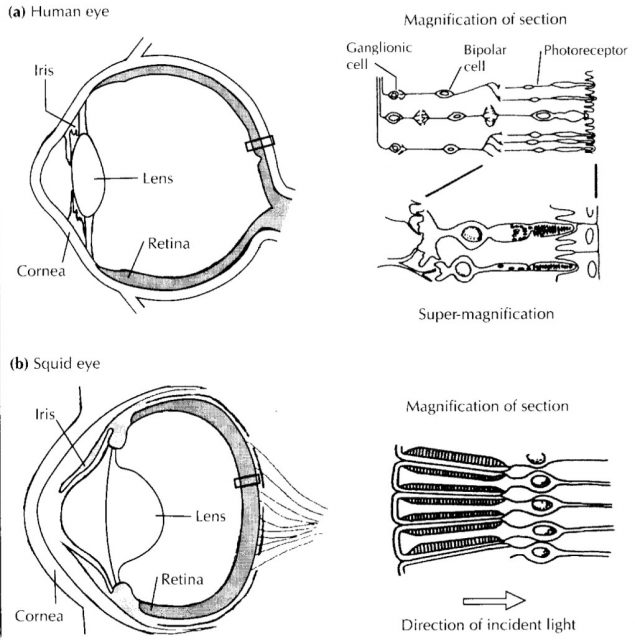Giant squids: keeping an eye on the enemy

It took a multi-million-dollar collaborationship between Discovery Channel and NHK to obtain the first images of a giant squid in its native environment. The broadcasters announced this month that they finally succeeded on filming a relatively small specimen of Architeuthis dux at a depth of 630m in the northern Pacific Ocean. But what makes this big cephalopod so elusive? Part of the answer could be that it is the result of the fact that they have the worlds biggest eyes.

In a nice example of convergent evolution, cephalopods have camera eyes that, like ours, have a lens an iris and a retina covered with photoreceptors (Fig 1). What is surprising about squids is that their eyes are exceptionally large with respect to their body; indeed giant squids have the biggest eye of any living animal. There are reports of giant squids with eyes as big as 30-40 cm, while the eye of the largest animal on Earth (the blue whale) has a diameter of 11 cm.
In a recent paper in Current Biology1, D.-E. Nilsson and his colleagues obtained photographic evidence of a (dead) giant squid with an eyeball of 27 cm in diameter and a 9 cm pupil, and set out to discover why this giant squid eye is so big. Its size seems to be the consequence of a arms race lasting several millions of years between species of giant squid and their relatively new predator, echolocating toothed cetaceans such as sperm whales (Physeter macrocephalus). Sperm whales, not much bigger than the giant squids themselves, submerge below 500 m to find prey and use one of the loudest echolocation signals known to detect the biggest squids to a range of up to 200 m. On the other hand, squids are deaf to the high frequencies used by the sperm whale for echolocation, and have to rely on vision to detect the approaching whale in time to escape.
Light is detected as quanta, and detection events for natural light follow Poissonian statistics. In particular, the variance (standard deviation squared) of photon detection is equal to the mean number of detected photons. At very low light levels, such as the ones encountered in the deep ocean, the standard deviation approaches or gets bigger than the mean photon detection and photon noise limits the resolution of the eye. Bigger eyes with big pupils that capture more light can minimise this problem, and can be an advantage for the giant squid in its task of detecting predators.
However, big eyes are costly to make and carry and a law of diminishing returns applies to eye performance, making increases in eye size less and less rewarding (due to light scattering and absorption by sea water). As a consequence there will be some size of eye where the advantages that result from an increase in size will be smaller than the disadvantages of building and carrying the bigger eye. This size of eye gives the squid greatest advantage. However, the characteristic of the tradeoff that define this optimum are quite different for different visual tasks.
Nilsson at al. considered three tasks: the detection of bright point sources and the detection of dark and bright extended sources. The range of detection for the three sources increases with the size of the eye, although all present laws of diminishing returns. There is a strong increase in performance for the detection of point sources with eye size up to a pupil diameter of 25 mm (corresponding roughly to an eye of 7 cm), while further increases in eye size bring an increasingly smaller reward. This theoretical finding fits with the experimental fact that eyes of pelagic animals rarely exceed 9 cm of diameter.
Performance for other tasks tend to plateau at bigger sizes, suggesting that the exceptionally big eyes of the giant squid is an adaptation for the detection of extended sources in very dim light. The low contrast extended sources that the giant squid is interested in are, of course, approaching whales. However, whales tend to look very differently at different depths. Towards the surface, they are seen as dark shapes against a bright background. At bigger depths, ambient light levels drops quickly, and swimming whales are better detected by the bioluminescence they elicit in marine microorganisms when swimming. The model shows that it is precisely in the detection of those low contrast luminous extended sources against a dark background when the big eyes of giant squids perform considerably better than smaller ones. The conclusion seems inescapable, giant squids have the world’s largest eyes to detect whales deep underwater, where light is dim and photons are few and far between.

Only one other group of animals are known to have had eyes as big as the giant squids, the Ichthyosaurs. With sizes not disimilar to giant squids, those extinct marine reptiles populated the seas before the whales appeared on scene. Nilsson and colleagues speculate that the Ichtyosaurs shared with giant squids the need for early detection of big predators, maybe the first step to know more about the ecology of these extinct reptiles.
References
- D.-E. Nilsson, E.J. Warrant, S. Johnsen, R. Hanlon, N. Shashar, “A unique advantage for giant eyes in giant squid”. Curr. Biol., 22 (2012), pp. 683–688 http://dx.doi.org/10.1016/j.cub.2012.02.031 ↩